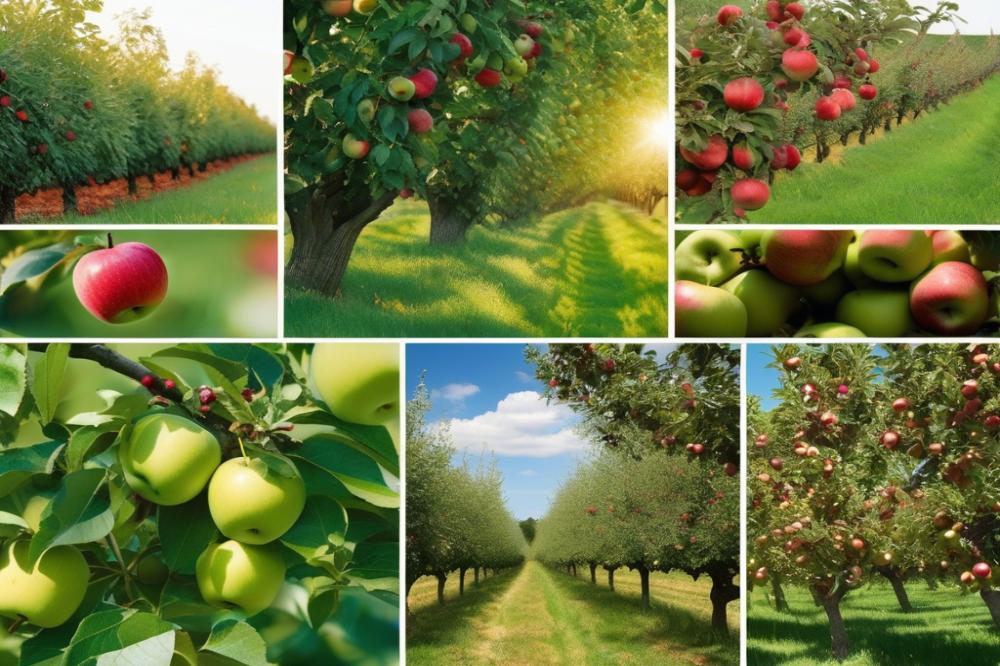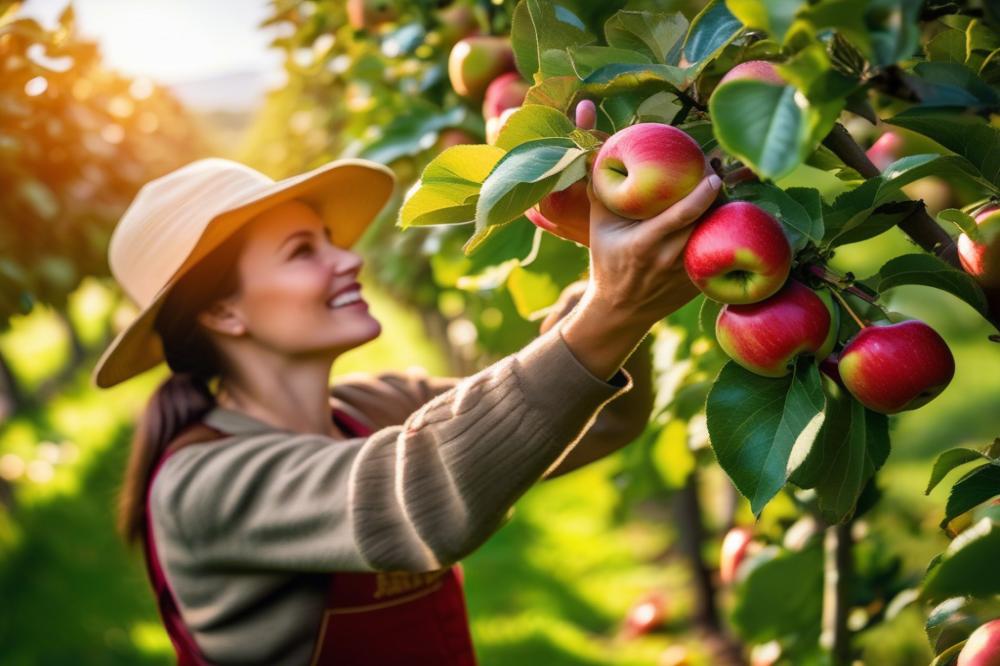harvesting apples: When and How to Pick Your Fruit
harvesting apples represents an essential part of the fruit-growing process. This activity not only impacts the quality of the fruit but also plays a vital role in the overall health of the tree. Picking apples at the right moment helps guarantee that the fruit is at its peak in flavor and nutrition. It can be an exciting time for gardeners eager to enjoy their efforts in the orchard.
Growing apples in your garden provides a rewarding and familiar experience. Many varieties flourish in various climates, offering a diversity of tastes and uses. Understanding the specifics about apple varieties can help you select the best type suited for your space and taste preferences. With the right care, trees can produce a bountiful harvest each season.
This article will guide you through the necessary aspects of apple picking. Details such as the best timing for harvesting, various techniques for effective picking, and essential tools will be covered. Post-harvest care will also be discussed, which is crucial for maintaining the quality of your fruit during storage. You will learn about the best methods to ensure your ripe fruit lasts as long as possible while retaining its flavor. By providing this information, we aim to help make your apple harvesting experience both enjoyable and successful.
Harvesting Apples: When and How to Pick Your Fruit

The best season for picking apples is typically late summer to early fall. This timeframe can vary based on your local climate and specific apple varieties. In warmer regions, harvest may start in August, while cooler areas usually see picking begin in September or October. Understanding the right timing is crucial for a successful harvest.
Different apple varieties also have unique harvest times. For example, early types such as Gala and Zestar! are ready to pick in late summer. Meanwhile, late-season apples like Fuji and Granny Smith might not be ripe until October. Local weather plays a significant role in the ripening process as well. Warmer days and cooler nights can speed up the ripening of fruit.
To determine if your apples are ready for harvesting, look for clear signs of ripeness. Color change is one of the first indicators. Bright, vibrant shades usually signal that the fruit is ready. Additionally, feel the apples; they should feel firm, not soft. A common test involves twisting the apple gently; if it comes off the tree easily, it is likely ripe.
When approaching the task of harvesting, there are several techniques to follow. Using the right tools makes the job easier and more efficient. A simple picking basket can hold your apples without bruising them. Some people opt for a fruit picker, which can reach higher branches safely. Always harvest in dry conditions to prevent damage to the fruit.
After gathering your apples, it’s essential to consider post-harvest care. Store your picked fruit correctly to maintain freshness. Apples should ideally be kept in a cool, dark place. A refrigerator or a root cellar works well for longer storage. Some varieties can last longer than others when stored properly.
Understanding your apples is vital. Different types require different handling techniques and storage conditions. Learning about apple varieties can help you enjoy the best flavors and textures. Whether baked in a pie or eaten fresh, good harvesting practices enhance the overall experience. Make the most of your orchard and enjoy the fruits of your labor.
Understanding Apple Varieties

When it comes to apples, many different varieties flourish in gardens. Each type has its own distinct flavor, texture, and intended use. Some common varieties include Granny Smith, Fuji, Honeycrisp, and Red Delicious.
Characteristics of Apple Varieties
Granny Smith apples are tart and crisp. They typically mature in late fall. The bright green skin is a clear sign of their readiness. Fuji apples offer a sweet explosion of flavor and are usually ready for harvest in early fall. Their firmness makes them great for fresh eating.
Honeycrisp apples have a renowned balance of sweetness and tartness. Their unique texture creates a satisfying crunch. These apples tend to ripen in early autumn. Red Delicious apples are known for their deep red hue and mild taste. However, harvesting these requires careful timing because they can become overripe quickly.
Best Practices for Knowing When Each Variety is Ripe
Observe the season closely for hints on ripeness. Color serves as one indicator, but it’s not the only one to consider. Firmness matters as well. For example, a ripe Granny Smith feels sturdy but slightly yielding. Checking the skin texture is also vital; it should appear more natural and less shiny.
Timing is crucial. Picking an apple too early will lead to sour and crunchy fruit, while waiting too long causes the apple to become mealy. Experienced gardeners often use several techniques for determining ripeness. Tasting a sample from the tree can offer honest feedback about flavor and texture.
Tools can make a difference in your harvesting methods. A simple apple picker helps reach higher branches. A gentle twist while pulling ensures the apples come off easily without damage. After picking, pay attention to storage. Proper conditions will prolong the freshness of your apples.
Understanding about apple varieties and their ripening signals can be rewarding. The right harvest techniques promote optimal results. Remember to handle your apples gently after picking, as this affects the quality and longevity of your fruit. Post-harvest care like keeping them cool and dry is just as important as the act of picking.
Harvesting Techniques and Methods

Effective harvesting methods are crucial for obtaining high-quality apples. Picking ripe fruit at the right time can make a big difference. Various techniques exist that make this task easier. Gentle picking is often favored as it prevents bruising. However, some tools can aid in the process, especially when apples are out of reach.
When deciding on tools, consider how they might affect the orchard’s health. Long-handled picking devices can be helpful for high branches. These tools often have a basket to catch the fruit. On the other hand, handpicking allows a closer inspection for ripeness and quality. This method is also kinder to the trees and ensures less damage.
To minimize damage, use careful handpicking techniques. Grasp the apple gently, rolling it upwards to snap off the stem. Doing this reduces the chances of bruising and preserves the fruit’s integrity. Always check for signs of overripeness, which can be common in certain apple varieties. Holding the apple firmly while twisting can prevent the flesh from tearing away.
Consider the timing of your harvest, as this impacts the overall quality. Mornings are often ideal since apples are cooler and firmer at that time. Picking on sunny days can increase the risk of bruises, as the fruit may be softer. Pay attention to the season; different apple varieties may have different peak times for harvesting.
Post-harvest care is vital to extending the life of your apples. Proper storage is key. Keeping them in a cool, dark place can maintain freshness. If bruising or damage occurs, handle those apples with extra care.
Learning about apple varieties can also enhance your harvesting experience. Some are more susceptible to damage than others. Understanding these differences helps tailor your harvesting methods to protect each type. Optimal care during picking and storage increases the likelihood of enjoying your harvested apples for weeks to come.
Essential Tools for Harvesting
Picking apples requires the right set of tools. The main equipment includes a sturdy ladder, a fruit picking bag, and pruners. A good ladder helps reach higher branches without risking a fall. Picking bags reduce the strain of carrying fruit by distributing weight evenly. Pruners are important for trimming branches and removing any damaged fruit. For those with larger orchards, a fruit picker tool simplifies the process by extending reach and collecting apples from the ground.
Choosing the appropriate tools depends on the size and layout of your orchard. Evaluate the types of apple varieties you are growing. Some trees may be taller or bushier, requiring unique equipment. Think about your personal comfort and physical ability too. If mobility is a concern, consider lightweight tools that won’t be tiring when working over several hours. The investment in durable tools pays off through multiple seasons.
Safety Equipment and Storage Considerations
Safety should always come first. Hard hats protect heads while working near branches. Gloves are essential to prevent cuts and scrapes. Additionally, wearing sturdy shoes reduces the risk of slips and falls. Lastly, a first aid kit should be nearby for those minor accidents that can happen during harvesting.
After harvesting, knowing how to store your tools is crucial. Clean collected fruit gently and allow it to dry before placing it in storage bins. This helps prevent bruising. Ensure tools are cleaned and stored in a dry place to avoid rust and damage. Consider hanging tools to save space and keep them organized. Proper maintenance of tools extends their life. Overall, thoughtful prep makes the harvesting season both efficient and safe.
Post-Harvest Care for Apples
After gathering ripe fruit from your orchard, the next steps are crucial to protect your apples. Best practices for handling apples begin as soon as you collect them. Use padded containers or crates to avoid bruising. Avoid stacking them too high, as this can cause pressure and damage. A gentle touch goes a long way in maintaining quality.
Cleaning and Sorting Techniques
Proper cleaning is necessary to remove dirt and residues. Rinse each apple under cool running water. Use a soft brush for stubborn spots. Do not use soap or chemicals, as these can affect flavor. After cleaning, sort the apples based on their quality. Separate those that show signs of damage or rot. Only the best apples should be kept for storage or sale.
Storage Methods for Maintaining Freshness
Choosing the right storage is essential for extending the life of your apples. Opt for a cool, dark place. Basements or cellars are often good options. Keep apples away from ethylene-producing fruits, like bananas. Such exposure can cause apples to ripen unevenly. Maintain humidity levels around 90% to prevent them from shriveling. Different apple varieties may require slightly different care; familiarize yourself with each type you have harvested.
Regularly check stored apples for spoilage. Remove any that show signs of decay immediately. This helps the remaining fruit stay fresh longer. Some tools, like a hygrometer, can help monitor conditions in the storage area. Remember, proper post-harvest care is key to enjoying your harvest throughout the season.
Wrapping Up Your Apple Harvest
Harvesting apples is a rewarding experience for any gardener. Knowing the right timing is crucial. Fruit should be picked when it’s fully ripe, so paying attention to color and firmness is important. This knowledge helps you enjoy the sweetest apples and makes for delicious recipes later on.
Celebrating your harvest brings joy. After all the hard work through the season, savor the fruits of your labor. If you have young ones, get them involved. Making the process a family activity can create cherished memories. Sharing fresh apples with friends and family can also spread joy beyond your garden.
Staying organized during the harvest is key. Gather the right tools before heading out. Having a sturdy basket or apple picker makes collection easier. Remember, gentle handling prevents bruising. Quick actions might seem tempting, but careful picking leads to better quality fruit.
Over time, gardening helps develop unique skills. Observe your apple trees throughout the season to learn their patterns. This insight will serve you well in future harvests. Each tree may have its own personality, and understanding these traits fosters a better yield.
Enjoy the process. Every fruit picked adds to the satisfaction of gardening. Think about planting more apple varieties next year. You might find new favorites that enhance your garden’s bounty. Overall, embrace the experience and celebrate your success with a delicious apple pie or a fresh cider!



